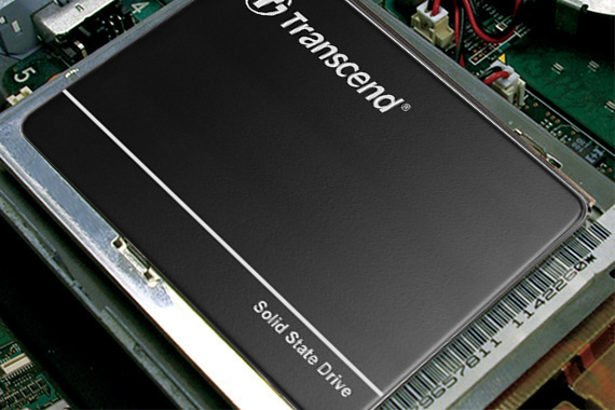Transcend Information, Inc., a leading producer of industrial-grade flash storage devices, is announcing its newly developed SuperMLC technology, a cost-effective flash storage solution with nearly equal performance to SLC NAND flash devices. Utilizing pre-selected high-quality flash chips and combining them with adjusted firmware coding, Transcend’s SuperMLC technology eliminates the performance bottleneck associated with smaller-capacity SSDs. SuperMLC technology is able to achieve 4 X the sequential write performance of MLC NAND flash, and up to 30,000 times of P/E (program/erase) cycles.
 Transcend’s SuperMLC technology is geared towards industrial-grade usage scenarios, such as fanless PCs, embedded automation computers and engineering machines. Transcend’s successful development of SuperMLC technology is the result of reprogramming the two bits per cell of MLC into one bit per cell to greatly boost its endurance and performance, especially with smaller-capacity SSDs. Although this practice effectively halves capacity by virtue of its double occupation of cells for two bits, the superior quality achieved is still a good tradeoff for industrial applications, creating quality that is nearly equal to that of SLC NAND flash, yet at a much more cost-effective price point.
Transcend’s SuperMLC technology is geared towards industrial-grade usage scenarios, such as fanless PCs, embedded automation computers and engineering machines. Transcend’s successful development of SuperMLC technology is the result of reprogramming the two bits per cell of MLC into one bit per cell to greatly boost its endurance and performance, especially with smaller-capacity SSDs. Although this practice effectively halves capacity by virtue of its double occupation of cells for two bits, the superior quality achieved is still a good tradeoff for industrial applications, creating quality that is nearly equal to that of SLC NAND flash, yet at a much more cost-effective price point.
Transcend plans to release several new industrial-grade SSD models in 2016 utilizing SuperMLC technology, including a 2.5” model (SSD510K), an mSATA model (MSA510), a half-slim SSD model (HSD510), and M.2 versions (MTS460 & MTS860). All of Transcend’s industrial-grade products undergo extensive testing through all stages of development to ensure high quality and long lifespan.
 You can view Transcend’s press release announcing the SuperMLC technology in its entirety here.
You can view Transcend’s press release announcing the SuperMLC technology in its entirety here.
 The SSD Review The Worlds Dedicated SSD Education and Review Resource |
The SSD Review The Worlds Dedicated SSD Education and Review Resource | 
Does anyone know what the actual cost to manufacturers differ between slc mlc tlc nand? Is it really that much, or are the manufacturers just trying to make ssds with the cheapest material they can, just as long as it hits benchmarks. I ask this because the price of tlc drives are not that much lower than mlc drives. Customer loses manufacturer / shareholders win.
Use a 240 – 256 gb ssd as an example, how much does it cost to manufacture slc mlc tlc nand? Does anyone know? Thanks in advance if anyone can answer this, or point me in the right direction to find the answer on my own.
Pricing heavily depends on quantity of buy (the more you buy, the cheaper), quality of chips and if its prepackaged or in die form.
Technically speaking, SLC/MLC/TLC are the same as far as hardware is concerned. You have a die, that has either 64Gbit of SLC flash, 128Gbit of MLC or 192Gbit of TLC.
Now this is all fine and dandy, this TLC. You have 3 bits per cell, effecticly increasing the capacity 3 fold compared to SLC or 50% compared to MLC.
But there is a caveat. Differentiating 8 different voltage states instead of 2 or 4 has a big toll on reliability and performance. While a typical SLC flash is good for 10s of 1000s of rewrites, TLC on the same node can be as little as few 100s rewrites. With TLC there are also associated performance issues (TLC has much longer program times) and reliability issues (electron leakage that happens to flash will cause cell to be unreadable quite faster than SLC or MLC — look at the 840/evo issue with reads).
All this means that in order to have a sorta reliable drive for client use, it requires additional spare space for error correction and bad blocks compared to MLC (apperently up to 20% of space is used just for that). Also, controllers need to have much much better error correction (like LDPC) which means additional complexity and cost.
So while TLC on its own is cheaper per gigabyte than MLC, all the extra cost it needs to operate reliably kinda eats away TLCs price advantage. Thats why TLC drives are not that much cheaper.
But things are improving.
Thanks for the detailed explanation!!! That has to be one of the best reply / explanation I have seen on a ssd forum. You Sir are spreading ssd knowledge!
Or is it simple math slc I bit, mlc 2 bit double profit, tlc 3 bit triple profit? at the expense of performance and supper error correction controllers?